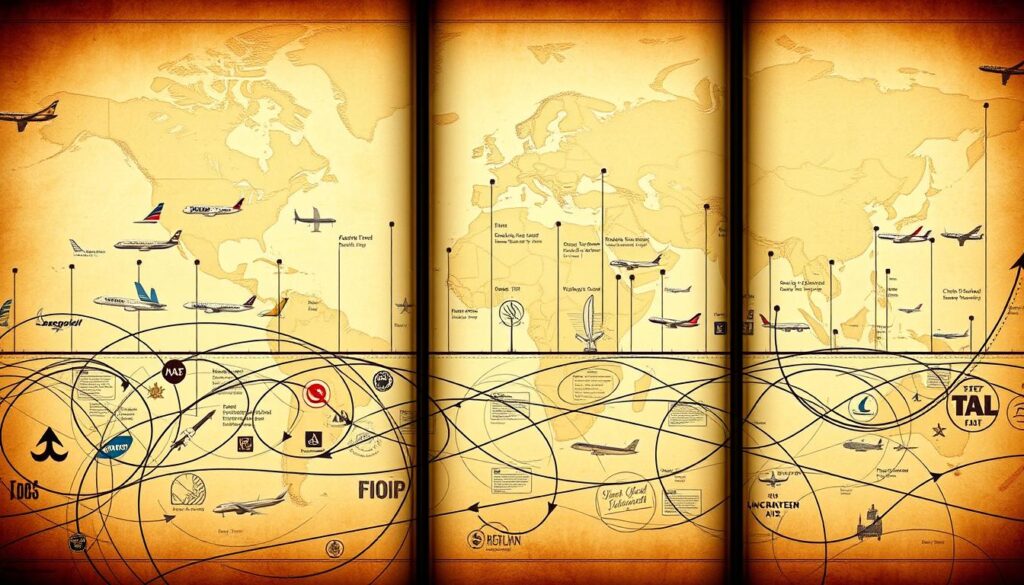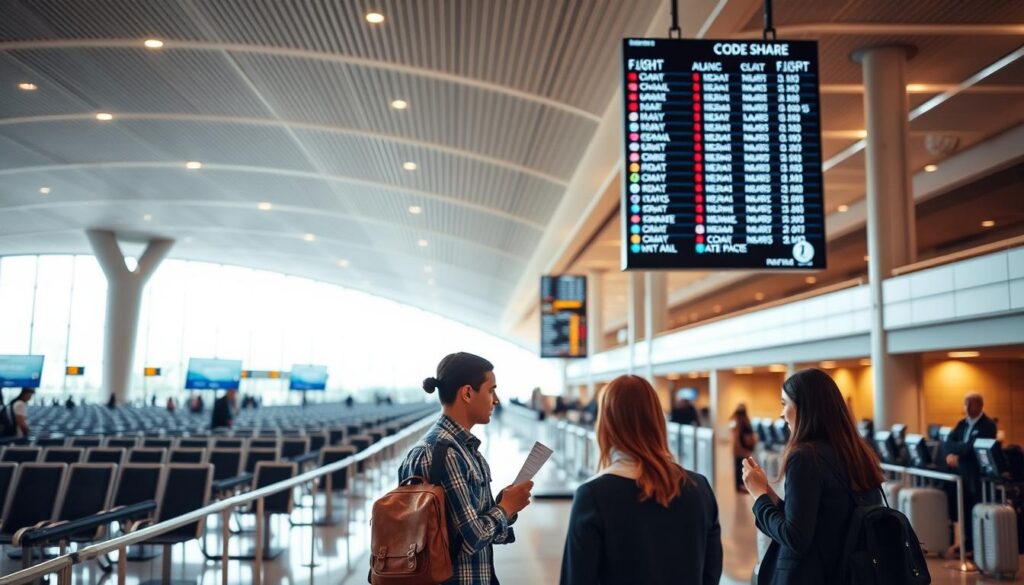What Is a Code-Share Flight and Should You Book It?
When booking a flight, you might come across the term “code-share flight.” But what does it mean? Simply put, a code-share flight is a partnership between two or more airlines that allows them to share the same flight under different flight numbers.
This collaboration is part of broader airline partnerships that aim to provide travelers with more options and seamless connections. By understanding code-share flights, you can make more informed decisions during the flight booking process.
Code-share flights can be beneficial, offering a wider range of routes and schedules. However, they can also be confusing, especially for travelers who are not familiar with the concept. In this article, we will explore the ins and outs of code-share flights to help you navigate your next flight booking with confidence.
Understanding Code-Share Flights
Through code-share agreements, airlines can provide their customers with a wider range of travel options without having to operate the flights themselves. This collaborative approach allows carriers to sell tickets on flights operated by their partner airlines, effectively expanding their network.
Code-share flights involve two main parties: the marketing airline and the operating airline. The marketing airline is responsible for selling tickets on the flight, while the operating airline is the one that actually operates the flight. This partnership enables airlines to offer more destinations to their customers, enhancing connectivity and convenience.
For instance, if an airline has a code-share agreement with another carrier, it can sell tickets to destinations it doesn’t directly serve. This means passengers can book a single ticket for a journey that involves multiple airlines, simplifying their travel experience. Code-share agreements also facilitate smoother connections between flights operated by different airlines.
By understanding how code-share flights work, passengers can better navigate their travel options and make informed decisions about their flights. Whether it’s for business or leisure, code-share flights offer a convenient way to reach more destinations worldwide.
The History and Evolution of Code-Share Agreements
Code-share agreements have a rich history that spans several decades, transforming the way airlines operate. The concept emerged as a means for airlines to expand their networks without having to operate additional flights.
Early Developments: Initially, code-share agreements were simple arrangements between two airlines. However, with the formation of airline alliances, these agreements became more complex and widespread. Alliances like Star Alliance, SkyTeam, and Oneworld facilitated the growth of code-share agreements, enabling airlines to offer more routes to their customers.

The evolution of code-share agreements has been driven by industry developments, including deregulation and the need for airlines to be more competitive. Today, code-share agreements are a standard practice in the airline industry, allowing airlines to cooperate and compete more effectively.
What Is a Code-Share Flight and Should You Book It?
Code-share flights have revolutionized the way we travel, offering more options and flexibility for passengers. By allowing airlines to partner on specific routes, code-share agreements enable travelers to access a broader network of destinations without the need for multiple bookings.
Enhanced Connectivity
One of the primary benefits of code-share flights is the enhanced connectivity they provide. Travelers can book a single ticket for a multi-leg journey, simplifying the travel process and reducing the risk of missed connections. This convenience is particularly valuable for complex itineraries involving multiple airlines.
When considering whether to book a code-share flight, it’s essential to weigh the advantages for travelers, including increased flight options and the convenience of a single ticket. While there are potential drawbacks, the benefits often outweigh these for many passengers, making code-share flights a viable and attractive option.
In conclusion, code-share flights offer a range of flight convenience benefits that can enhance the travel experience. By understanding how these agreements work and what they offer, travelers can make informed decisions about their bookings.
Benefits of Booking Code-Share Flights
Code-share agreements between airlines provide a more streamlined travel experience. By partnering with other airlines, carriers can offer a wider range of routes and schedules, making it easier for travelers to find convenient flights.
One of the primary benefits of code-share flights is the simplification of travel arrangements. With code-share agreements, travelers can book a single ticket for a journey that involves multiple airlines, reducing the complexity of managing separate bookings.

Coordinated flight schedules are another advantage of code-share flights. Airlines work together to ensure that connecting flights are timed efficiently, reducing the risk of missed connections and minimizing travel disruptions.
Furthermore, code-share flights often come with the convenience of streamlined check-in and baggage handling. Travelers can check in once and have their baggage transferred between flights, making the travel experience smoother.
Additionally, airline partnerships allow travelers to earn and redeem frequent flyer miles across partner airlines, enhancing the overall travel experience and providing more rewards opportunities.
Potential Drawbacks of Code-Share Flights
While code-share flights offer convenience, they also come with certain drawbacks that travelers should be aware of.
One of the main issues with code-share flights is the potential for service variability across different airlines. Since code-share flights involve multiple airlines, the level of service can differ significantly depending on the operating carrier.
For instance, check-in procedures, baggage handling, and in-flight services may vary. Travelers might check-in with one airline but receive their boarding pass and baggage tag from another, potentially causing confusion.
Moreover, airline policies can differ significantly, including policies on baggage allowance, meal service, and loyalty programs. This variability can lead to a disjointed travel experience if not managed properly.
To mitigate these issues, travelers should research the operating carrier and understand their policies before booking a code-share flight. Being aware of the potential code-share drawbacks can help travelers prepare and minimize any disruptions during their journey.
When Code-Share Flights Make the Most Sense
Code-share flights offer a convenient solution for travelers heading to smaller cities with limited flight options. These agreements between airlines enable passengers to reach their destinations more easily, even when direct flights are not available.
Code-share advantages are particularly noticeable for travelers planning trips to areas with underdeveloped air travel infrastructure. By partnering with other airlines, carriers can offer a more comprehensive network of routes, enhancing overall travel planning flexibility.

For instance, a passenger might book a flight with one airline, but the actual flight is operated by another airline as part of a code-share agreement. This arrangement can provide more flight options and often results in a smoother travel experience.
By understanding when code-share flights are most beneficial, travelers can make informed decisions about their travel arrangements, potentially saving time and enhancing their overall travel experience.
Tips for Successfully Navigating Code-Share Flights
Code-share flights can be confusing, but with the right tips, you can navigate them successfully. To start, check your itinerary carefully to identify code-share flights and understand the operating airline. This information is crucial for a smooth travel experience.
Understanding the roles of marketing and operating airlines is also vital. The marketing airline is the one that sells the ticket, while the operating airline is the one that actually flies the plane. Knowing this can help you manage check-in and baggage handling more effectively.
When checking in, ensure you’re aware of the operating airline’s policies, including baggage allowances and check-in times. By being informed, you can avoid potential issues and enjoy a hassle-free journey.
Code-Share Flights: A Traveler’s Perspective
Code-share flights have revolutionized the way we travel, offering a range of benefits from enhanced connectivity to simplified travel arrangements. As airline partnerships continue to grow, understanding the intricacies of code-share agreements is crucial for making informed travel decisions.
In conclusion, code-share flights provide a convenient and often cost-effective way to reach destinations worldwide. While there are potential drawbacks to consider, the benefits of code-share agreements far outweigh the negatives for many travelers. By being aware of how code-share flights work and what to expect, travelers can navigate the complexities of modern air travel with ease.
A travel summary of the key points reveals that code-share flights are an integral part of the airline industry, enhancing the travel experience through streamlined check-in, baggage handling, and coordinated flight schedules. As the airline industry continues to evolve, code-share partnerships will remain a vital component of global air travel.
